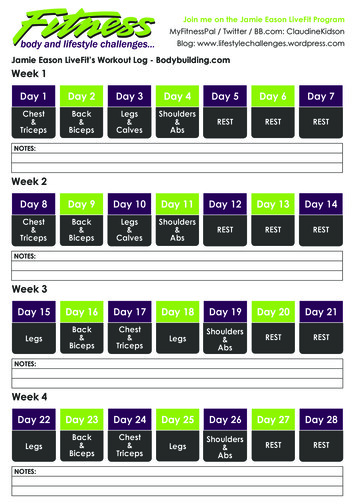
Transcription
MiSight 1 Day(omafilcon A)SOFT (HYDROPHILIC) CONTACT LENSES FOR DAILY WEARPROFESSIONAL FITTING ANDINFORMATION GUIDENOVEMBER 2019Part Number: PFG01040Revision: APage 1 of 7Revision Date: November 14, 2019
TABLE OF CONTENTSPRODUCT DESCRIPTION .3LENS PARAMETERS AVAILABLE.3ACTIONS .3INDICATIONS (USES).3CONTRAINDICATIONS, WARNINGS, PRECAUTIONS, AND ADVERSE REACTIONS.4SELECTION OF PATIENTS .4FITTING PROCEDURE .4PRE-FITTING EXAMINATION .4INITIAL LENS SELECTION .4INITIAL LENS EVALUATION .4LENS FIT GUIDELINES.5CHARACTERISTICS OF A TIGHT-FITTING LENS .5CHARACTERISTICS OF A LOOSE-FITTING LENS .5PATIENT INSTRUCTION .6RECOMMENDED WEARING SCHEDULE .6FOLLOW-UP CARE.6CARE OF LENSES .7HOW SUPPLIED.7REPORTING ADVERSE ACTIONS .7Part Number: PFG01040Revision: APage 2 of 7Revision Date: November 14, 2019
PRODUCT DESCRIPTIONMiSight 1 Day (omafilcon A) Soft (Hyrophilic) Contact Lenses for Daily Wear are made from a materialcontaining 60% water and 40% omafilcon A, consisting of 2-hydroxy-ethylmethacrylate and 2methacryloyloxyethyl phos-phorycholine polymers cross-linked with ethyleneglycol dimethacrylate. Thelens material has a permanently fixed tint using Vat Blue 6, which is added to make the lens more visiblefor handling.The optic zone design is a concentric ring design with alternating vision correction zones and treatmentzones (shaded in diagram). Zones 1 and 3 are vision correction zones and the label power of the contactlens. Zones 2 and 4 are treatment zones with 2 diopters of defocus to slow the progression of myopia.The physical/optical properties of the lens are:o Refractive Index:o Light Transmittance:o Water Contento OxygenPermeability:o1.40 at 25 C 90%60% 2%25 x10-11 (cm2/sec)(ml 02/ml x mmHg) (Polarographic FATT Method)LENS PARAMETERS AVAILABLEDiameterBase CurveCenter ThicknessSphere Power14.2 mm8.7 mm0.08 mm to 0.14 mm (varies with power)-0.50 D to -7.00 D; 0.25D stepsSee Price List for Detailed AvailabilityACTIONSWhen placed on the cornea in its hydrated state, the MiSight daily wear single use (omafilcon A) Soft(Hydrophilic) Contact Lens acts as a refracting medium to focus light rays on the retina and tosimultaneously provide an optical stimulus to slow the progression of myopia.INDICATIONS FOR USEMiSight 1 Day (omafilcon A) Soft (Hydrophilic) Contact Lenses for Daily Wear are indicated for thecorrection of myopic ametropia and for slowing the progression of myopia in children with non-diseasedeyes, who at the initiation of treatment are 8-12 years of age and have a refraction of -0.75 to -4.00Part Number: PFG01040Revision: APage 3 of 7Revision Date: November 14, 2019
diopters (spherical equivalent) with 0.75 diopters of astigmatism. The lens is to be discarded after eachremoval.CONTRAINDICATIONS, WARNINGS, PRECAUTIONS, AND ADVERSE REACTIONSPlease refer to the Package Insert (PI01082).SELECTION OF PATIENTS The MiSight Soft Contact Lenses can be prescribed to patients who require vision correction anddesire to slow the progression of myopia. Parental consent and cooperation when fitting young children is important. Patients selected to wearMiSight Soft Contact Lenses should be chosen for their motivation to wear contact lenses, generalhealth and cooperation. Patient hygiene and ability to follow practitioner instructions are essential tosuccess.FITTING PROCEDUREPRE-FITTING EXAMINATION An examination, including personal and family history, refraction, keratometry, biomicroscopy, andother pertinent tests and measurements should be performed to rule out contraindications to contactlens wear as described in the Package Insert. If the patient has the necessary qualifications and nocontraindications exist, the patient may be considered for fitting.INITIAL LENS SELECTION MiSight (omafilcon A) contact lenses are available in a single base curve and diameter. The soft lenspolymer and thin lens design allow for draping across a broad range of corneal curvatures. Initial lens power is determined from the patient’s spherical equivalent prescription corrected to thecorneal plane. A cycloplegic refraction can be a helpful baseline reference before an initial fitting ofMiSight lenses. Because of the dual focus optical design of MiSight lenses, it is best to start withmaximum plus/least minus lens power that prides good visual acuity. Place the lens on the eye. Allow the lens to remain on the eye long enough to achieve a state ofequilibrium. Small variation in the tonicity, pH of the lens solutions and individual tear compositionmay cause slight changes in fitting characteristics. The lens should cover the patient’s cornea fully, provide discernible movement (0.2 mm to 0.5 mm isideal) after blink, be comfortable for the patient and provide satisfactory visual performance. Full coverage of the cornea is defined as the lens edge extending beyond the limbus area in alldirections. Initial lens evaluation must be done after at least 10 minutes of lens wear to allow the lensto stabilize and any tearing to subside.INITIAL LENS EVALUATION Comfort - If the patient experiences lens awareness or discomfort, check to make sure there is noforeign matter under the lens, or the lens is not inside-out or damaged.Part Number: PFG01040Revision: APage 4 of 7Revision Date: November 14, 2019
Lens Centration and Movement - Excessive decentration or lens movement may result in unstablevision and is often a sign that the lens is loose. A 0.2mm to 0.5mm range of movement is ideal. SeeLENS FIT GUIDELINES below. Visual Acuity and Power Adjustment - Visual acuity of 20/20 should be achievable for sphericalcorrections or with low amounts of astigmatism. To avoid over-minusing, reduce minus in 0.25D stepsprovided there is no decrease in acuity and no subjective visual impact. Increase minus in 0.25Dsteps only if it significantly improves distance vision. Vision Quality - MiSight lenses provide an optical correction that simultaneously presents one image“in-focus” and a second image “out-of-focus.” Under certain circumstances (such as low light levels),this optical design can cause reduced image contrast, symptoms of ghost images, and/or glare orhalos around bright lights. See the related Warning concerning these problems in the Package Insert.Final Lens Selection - Fitting performance and visual response should be confirmed with theprescription lenses prior to dispensing and the management of certain adaptive symptoms should bediscussed with the patient prior to dispensing.LENS FIT GUIDELINESCharacteristics of a Well-fitted LensA well-fit MiSight Contact Lens best satisfies the following criteria: Full corneal coverage in all directions of gaze. Good centration (concentric about the visible iris). Satisfactory lens movement (0.20 to 0.50 mm with blink is ideal) The lens moves freely when manipulated with digital pressure against the lower lid. Satisfactory comfort response by the patient. Satisfactory vision response by the patient.CHARACTERISTICS OF A T IGHT-FITTING LENSA tight-fitting MiSight Contact Lens would display some or all of the following characteristics: Good centration. Little or no movement with blink or up gaze lag. The lens resists movement when manipulated with digital pressure against the lower lid. Good comfort Vision may be blurred and clear immediately following blink. Bubble(s) under the lens. Conjunctival indentation and/or blanching of limbal vessels at the lens edge. Limbal-conjunctival hyperemia.CHARACTERISTICS OF A LOOSE-FITTING LENSA loose-fitting MiSight Contact Lens would display some or all of the following characteristics: Decentration (usually temporally and/or superiorly). Excessive up gaze lag ( 1.0mm).Part Number: PFG01040Revision: APage 5 of 7Revision Date: November 14, 2019
Reduced comfort response-usually lower lid sensation. Unstable vision.PATIENT INSTRUCTION When fitting contact lenses to children, it is important that the child is able to insert and removelenses by themselves but that the parents are aware and knowledgeable as well. Discuss with theparents the best approach for their child. Instruct the patient on the technique for soft lens insertion and removal. Insertion and removal is donein the conventional manner used for soft hydrophilic contact lenses. Provide written instructions and acopy of the MiSight (omafilcon A) Contact Lens Patient Instruction Booklet. It is advisable to reviewthese instructions carefully with your patient but also with their parent(s) . It is normal for the new wearers to experience mild symptoms such as lens awareness, variablevision, occasional tearing (watery eyes) and slight eye redness during the adaptation period.Although the adaptation period varies for each individual, generally within a few days these mildsymptoms will disappear. If these symptoms persist, the patient should be instructed to contact theireye care practitioner.RECOMMENDED WEARING SCHEDULE New contact lens wearers may wish to increase their wearing time slowly over the first week as theyadapt to handling and wearing lenses. A suggested maximum wearing time for the first week may beas follows:DAYDay 1Day 2Day 3Day 4Day 5Day 6HOURS68101214All wakinghours Based on the clinical study, it is recommended that the patient wear the lens for a minimum of 10hours per day for at least 6 days per week. Daily wear lenses are not indicated for overnight wear,and patients should be instructed not to wear lenses while sleeping. The MiSight lenses are indicated for daily disposable replacement. The lenses should be thrown outat the end of each day.FOLLOW-UP CARE It is recommended during the first several months of wear, that children wearing contact lenses seetheir eye-care practitioner more often to assure good contact lens hygiene practices are developed. Thereafter, it is recommended that a contact lens-wearing patient see his or her eye-care practitionerat least twice each year. Follow-up Care for contact lens wear should include at least the following:oCase history/ symptomsoVisual acuity and over-refraction. Avoid over-minusing as described above.oCheck lens fit (see LENS FIT GUIDELINES)Part Number: PFG01040Revision: APage 6 of 7Revision Date: November 14, 2019
oBiomicroscopic examination (with and without the use of fluorescein) of the cornea, conjunctivaand lids.If any of the above observations are judged to be abnormal, professional judgment is to be used inalleviating the problem and restoring the eye to optimal conditions. Prescribe new lens power if necessary.CARE OF LENSESMiSight (omafilcon A) Soft (Hydrophilic) Contact Lenses are indicated for daily wear single use only. Thelenses are to be discarded upon removal. Therefore, no cleaning or disinfection is required.Please refer to the Package Insert and the Patient Information Booklet for more information.HOW SUPPLIEDEach lens is supplied sterile in a blister containing sterile isotonic buffered saline solution. The blistersare packed in boxes. The following information is provided: the base curve, diameter, dioptric power,manufacturing lot number of the lens and the expiration date of the product.REPORTING ADVERSE ACTIONSAll serious adverse experiences and adverse reactions in patients wearing the MiSight 1 DAY (omafilconA) Soft (Hydrophilic) Contact Lens or experienced with the lenses should be reported to:CooperVision, Inc.Attn: Product Services711 North RoadScottsville, New York 14546(800) 341-2020www.coopervision.comPart Number: PFG01040Revision: APage 7 of 7Revision Date: November 14, 2019
The MiSight lenses are indicated for daily disposable replacement. The lenses should be thrown out at the end of each day. FOLLOW-UP CARE It is recommended during the first several months of wear, that children wearing contact lenses see their eye-care practitioner more often to assure good contact lens hygiene practices are developed.

![Welcome [dashdiet.me]](/img/17/30-day-weight-loss-journal.jpg)








